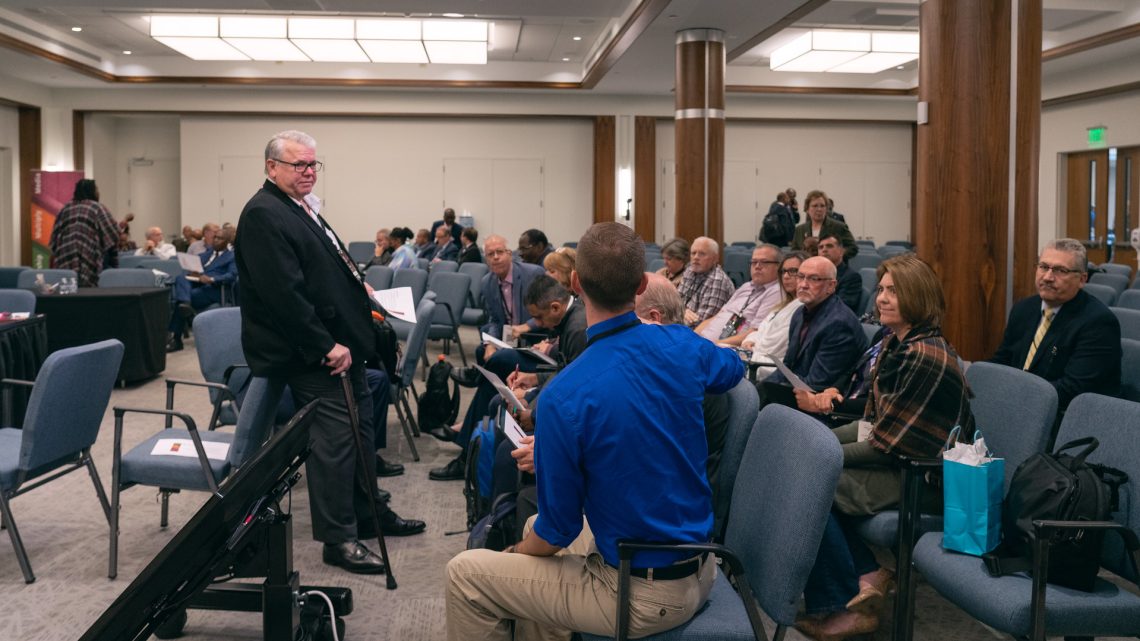On Sunday, Oct. 30, breakout groups tackled the daunting and relevant topic of online churches. The pandemic brought to light the limitations but also the possibilities of hosting church online, and as a result, the post-pandemic world is looking at online communities entirely differently than they did pre-COVID.
“We need some direction in terms of trying to shape our future as we move in this direction,” stated Bryant.
The five questions breakout groups were tasked with responding to were:
- What does the ideal local church environment look like, and can these ideals be transferred to the digital environment?
- What does the optimal church-conference relationship look like, and can this be transferred to the digital environment?
- What are the positives and negatives of having an online church?
- Should a new tithe paradigm be considered, and if so, what would it look like?
- Should there be a new way to handle members?
Though the general consensus was that in-person church was still the best model, most unions acknowledged not only the necessity of online options, but also their value.
“The advantages to in-person services are many,” commented Jim Davidson, executive secretary for the Southern Union; “but at the same time we realize that to leave no person behind means we have to continue a digital presence and format, especially for our younger people. For us, this was a pandemic solution; young people were doing it long before COVID changed our lives. We have to find a way to provide an online experience that is not only a worship service but an opportunity to fellowship and participate in all the kinds of things we do in person.”
Defining the differences between “online presence” and “online church” remained a constant thread throughout the discussion,
with several unions pointing out that creating an online church meant doing more than simply providing a live-streamed sermon each week. Another regular concern was ensuring accountability so not just anyone could start an online “Adventist” church.
“Membership really has never been confined to time and space,”
commented Ingrid Pierre, young adult delegate from the Northeastern Conference in the Atlantic Union, as she reported back from the breakout session. “Even in our local churches we commute outside of our own communities to attend church. Online church has a place, but it must be structured, defined, and outlined so that members and leaders of the online church are practicing appropriate policies just as they are in our brick and mortar churches.”
Solutions to the challenge of online churches ranged from hiring influencers to establish and manage them, to creating a virtual reality church within the Metaverse, to placing digital strategists in each conference to assist with developing online communities. Unions also suggested a change in pastoral training at the seminary to include online churches.
Regarding a new tithing system for online churches, in general the responses were against this. Most unions felt the current system should continue to work, with tithe collected from online church congregations going toward supporting those online churches. It was also mentioned several times, however, that education of the general layperson on exactly how tithe works is necessary.
“Many, if not most, of our young people have no clue as to where a dollar goes when it’s returned in tithe,” commented Davidson (Southern Union). “We thought the church would get a lot more engagement in tithe if people really understood how those dollars are used.”
Across the board, response to this conversation topic was positive, if a bit trepidatious. Several attendees stood to express their appreciation and gratitude for the discussion.
“A year ago this would have just been about streaming,” commented Charles Tapp, president of the Potomac Conference. “We need more than that. When Jesus called His disciples, He told them to cast a net, and He’s asking us to cast a different net today. We need to use it to God’s glory.”
Wood (NAD) also commented, “Online church offers us the privilege to connect with our young people whom we thought had walked away from the church. They didn’t; they just moved into the virtual world. We have now been tasked with the honor of modifying our church structure and policies to make this thing called ‘church’ work for the next generation, and we cannot stop moving forward on this.”
The four focus areas identified on this topic for the coming year were:
- Establishing best practices for digital hybrid churches to allow for engaged, healthy, missional congregations;
- Embracing the digital church strategically and with intentionality under conference or local church accountability;
- Educating and creating guidelines to standardize membership, tithing, online attendance, and mission for online churches; and
- Finding ways to engage each other and guests online to meet pastoral, social, and other needs.
The original version of this story was posted on the North America Division of Seventh-day Adventist Church website.










